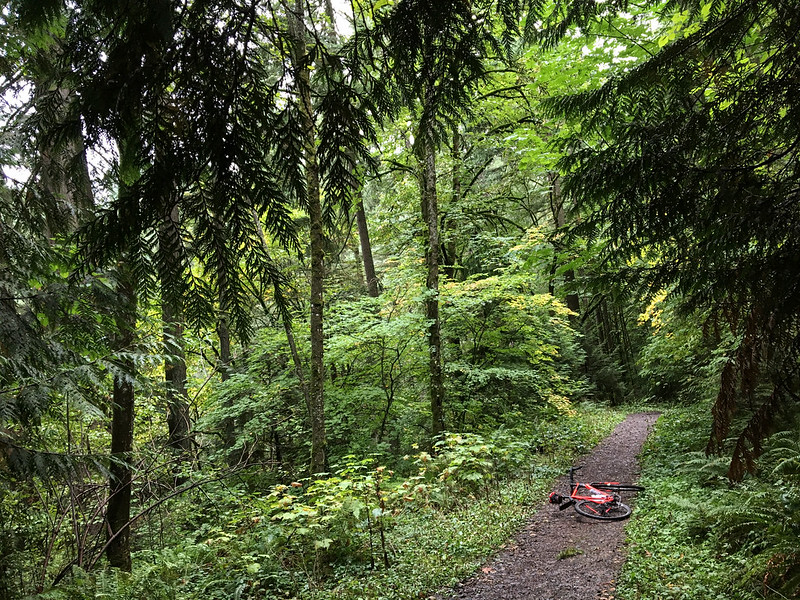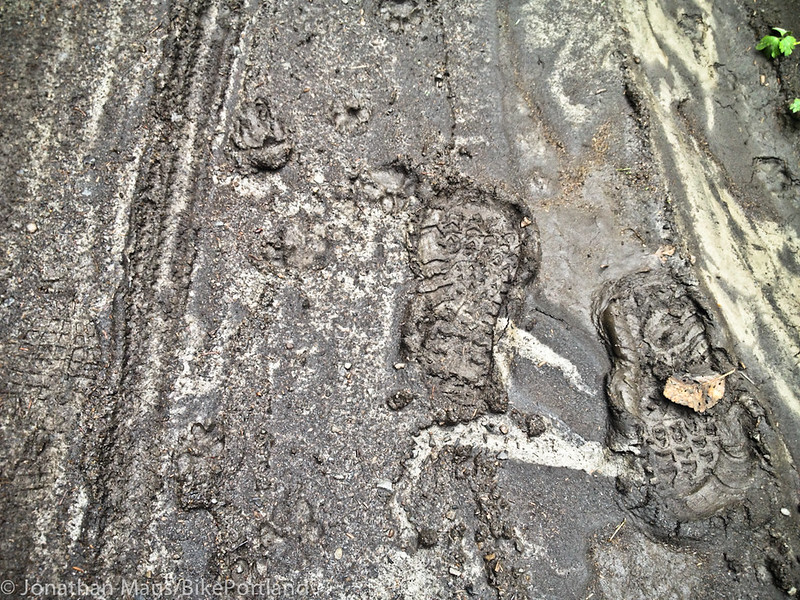
(Photos by J. Maus/BikePortland)
This post was written by Daniel Greenstadt. Daniel last appeared on BikePortland for his testimony in favor of funding the off-road cycling plan at City Council in 2015. He’s a Portland-based hiker, bicycle rider, Girl Scout leader, and occasional equestrian trail user who also serves on the Board of Directors of the Concordia Neighborhood Association.
——

You already may be paying some attention to Portland’s Off-Road Cycling Master Plan (ORCMP). As the process now goes public, both online and in a series of open houses, I’ve had a lot of conversation with friends and colleagues about what kinds of input may be necessary, useful or effective in helping to steer the ORCMP in a direction that will lead to the best possible outcome both for land conservation and for off-road cycling opportunities in our city and region. I see those goals as complementary.
The ORCMP is a sprawling and evolving process and it certainly contains some very hopeful elements. But there are others that are cause for great concern and, more importantly, urgent action.
I encourage you to “vote and vote often” throughout the ORCMP process in order to ensure that your perspective is part of this discussion. Because I’ve heard quite a bit of confusion about some aspects of the plan, I’d like to share a snapshot of the issues and concerns as I see them. I hope this discussion will inspire your own thoughts and questions about how you can best contribute.
We’ve come a long way — but where are we, exactly?
“Forest Park stands to gain or lose quite a bit under the ORCMP and it currently remains very unclear where it will end up.”
First, I am very glad that we’ve come this far. Off-road cycling has been fighting an uphill battle (in the big chainring) for at least two decades with regard to gaining any reasonable level of accommodation on our local public trails. When former Mayor Charlie Hales announced in April 2015 that he would support a process and funding for the ORCMP, it appeared to be the first time that the city was going to take the issue seriously. But nobody knew what such a master plan really meant so the news was greeted by many with a combination of great enthusiasm and a bit of understandable suspicion. Too many promises had been made and broken in the past. But the ORCMP seems to mark a new era. So how is it looking so far?
The ORCMP stands to do many great things for families around the city. Combined with other facilities already existing or underway such as Gateway Green, Powell Butte, Ventura Pump Track, and Eichler Park (Beaverton), the plan holds out the promise that adults and children throughout the city and region will have greater opportunities for health-filled, accessible, family-friendly outdoor recreation. I’m using my small voice in the ORCMP process to encourage as much of that good stuff as possible. Nobody knows better than you and your neighbors what type of facilities may fit best in your local community so please spread the word and encourage participation.
The elephant in the room: Forest Park
But the ORCMP also has an elephant in the room. It’s 5,100 acres big and it stretches from downtown all the way to NW Newberry Road. Forest Park stands to gain or lose quite a bit under the ORCMP and it currently remains very unclear where it will end up. While some modest amount of singletrack cycling can happen elsewhere in Portland, Forest Park is the only place where significant singletrack riding opportunities can be created. In my view, the ORCMP is currently headed for little to no improvement in singletrack access in Forest Park. Here’s why.
“Based on the experience of other cities with comparable situations, an open space like Forest Park might accommodate upwards of 20-30 miles of high-quality, ecologically sustainable, bicycle-friendly singletrack trail.”
There is no indication that the ORCMP is going to produce the type of grand vision that would suit a city like Portland with a very large open space park like Forest Park. Other cities and communities around the country have demonstrated successful approaches to similar situations in which they are balancing conservation and recreation priorities through integrated planning and best management practices. Those efforts are successful typically because they include strong leadership within local government. That has never been the circumstance here in Portland’s recreational trail culture, especially in relation to off-road cycling. That leadership is still lacking, which is why you are so important.
But what should you do with your voice?
Advertisement
For context, here, here and here are just a few examples of management plans from other cities that Portland could be drawing from and aspiring to in Forest Park. Of course, conditions vary by location but these plans can offer many lessons. Are we learning? Based on the experience of other cities with comparable situations, an open space like Forest Park might accommodate upwards of 20-30 miles of high-quality, ecologically sustainable, bicycle-friendly singletrack trail. Currently, Forest Park has essentially none, and the ORCMP may generate little improvement.
What happens in those other cities mentioned above are conservation, recreation, and land management stakeholders working together as a community to address issues surrounding environmental, safety, and trail user experience. The overall goal is a sustainable recreational trails system that serves all users while advancing conservation priorities. The ORCMP is a city-wide master plan rather than a park-specific management plan, but if the ORCMP produces only a modest and highly constrained vision of Forest Park, any subsequent management plan changes or improvements will be severely crippled. While the vision and desired outcomes of the ORCMP are generally good on paper, there are a number of issues and impediments – both internal and external to the ORCMP itself – that will negatively impact the ultimate outcome in Forest Park.
Off the table before we came to the table
“Recommendations for which specific trails should serve which specific combinations of users should be part of the ORCMP process and should be based on data and best practices.”
Before the ORCMP Project Advisory Committee (PAC) even began its work, the city removed from consideration all current pedestrian-only trails in the southern section of the park as well as the entirety of the Maple Trail and the Wildwood Trail in all sections of the park. At the master-planning level, it would seem improper to preemptively remove any specific trail or option from consideration by the body charged with making such determinations. It may be perfectly reasonable to establish a goal that the ORCMP should preserve or create significant pedestrian-only trail opportunities, but recommendations for which specific trails should serve which specific combinations of users should be part of the ORCMP process and should be based on data and best practices.
One practical reason that these preemptory exclusions are so important lies with the Wildwood Trail. In the northern section of the park, it seems virtually certain that the city intends to ban any new trail construction. If the Wildwood Trail remains off limits to bicycle use, there will never be a singletrack cycling experience in the northern section, nor will there be any singletrack connection to bicycle-friendly trails that Metro is developing on its lands in the North Tualatin Mountains. People who hike, walk, and run in the park, however, will continue to enjoy exclusive access. This whole issue has now lead to confusion and consternation among some of the project’s advisory committee members. It’s time for you, the public, to get involved.
Portland’s trail design standards are out-of-date
Both the 1995 Forest Park Natural Resources Management Plan (FPNRMP, page 174) and the City of Portland’s 2009 Trail Design Guidelines contain standards and technical information that are out of date, internally inconsistent, and are based on external standards that had been superseded even prior to the city’s adoption of the guidelines in 2009. The result is a confused set of trail planning and construction guidelines that aggravates some of the most fundamental issues surrounding environmental protection and trail user experience that are at the heart of the ORCMP process. While the city has hinted that the ORCMP may suggest changes or improvements to these outdated documents, there has been no detailed discussion or sense of urgency thus far within the ORCMP process. Unless these issues are clearly and strongly elevated in the ORCMP discussion (by you?), then any potential recommendations for changes to trail use designations or for new trail construction will never be realized.
The problem with the FPNRMP standards mostly boils down to the page 174 guideline requiring that any trails used by bicycles have a minimum tread width of 8 feet and a surface of “hard packed dirt or gravel.” That is a dangerous and environmentally unsound standard for a variety of reasons, and it is totally out-of-step with modern trail design practices. (The problems with the city’s 2009 Trail Design Guidelines are a bit more complex. Read my detailed analysis here.)
Taken together, these outdated guidelines prevent Portland land managers from using many of the most basic tools and techniques for constructing sustainable trails, controlling trail user speeds, and delivering high quality trail experiences for all users.
Project ‘screening tool’ makes new trails nearly impossible
In addition to the trail planning and design documents described above, any potential ORCMP recommendations regarding Forest Park will also face something called the Forest Park Project Objective Screening Tool (POST). While the POST has been mentioned during ORCMP advisory committee meetings, it has received no detailed discussion or analysis. And this is particularly alarming because the POST stands to halt virtually any kind of recreational trail planning or improvements in Forest Park. The POST was developed by the city in 2013 (adopted 2014) with little to no input from recreational stakeholders. While the POST may represent a worthwhile goal (rational and transparent decision making), it is far from “objective” in many regards and it creates a very significant impediment to Forest Park ever being the site of a modern, sustainable, recreational trails system for any users. A detailed discussion of the POST is too burdensome for this essay, so I would simply ask that you keep the POST in mind as you offer the city your input, questions and concerns.
Speaking of which, head on over to the City’s online open house and lend your voice to this plan today.
— Daniel Greenstadt
BikePortland is supported by the community (that means you!). Please become a subscriber or make a donation today.



